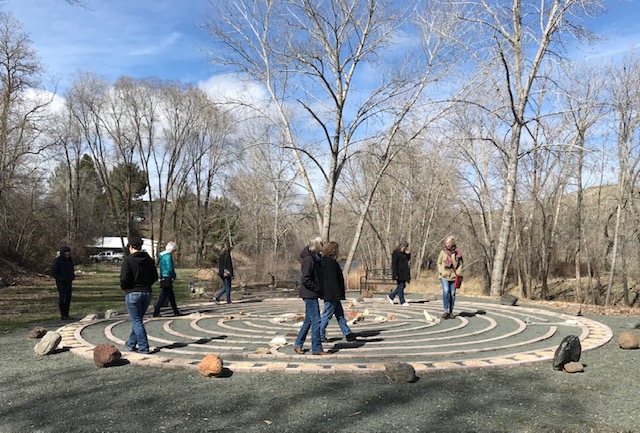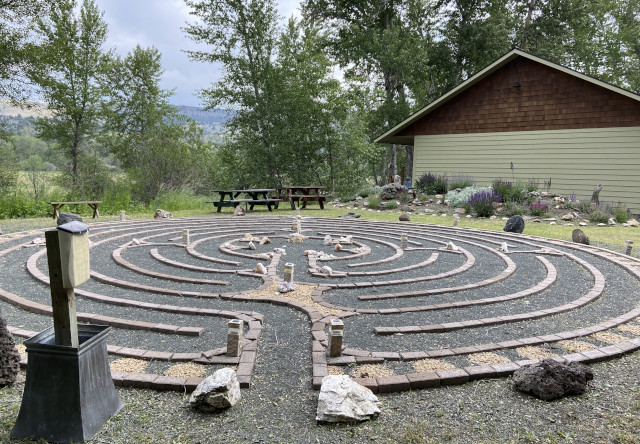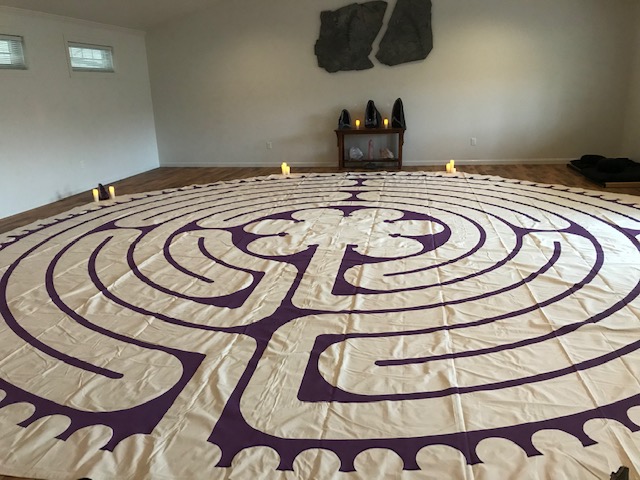CANYON
MOUNTAIN
CENTER
7 CIRCUIT LABYRINTH
We have a 36-ft. outdoor labyrinth that is open to the public, and a 24-ft. canvas labyrinth that can be used inside CMC during inclement weather. The canvas labyrinth is portable and can be taken to other locations for special events or educational purposes. Sandy Bay is a Certified Veriditas Labyrinth Facilitator and would be happy to provide more information or do a labyrinth presentation for your group or organization. Come to CMC to walk the outdoor labyrinth at any time. Please call Sandy in advance if you would like to bring a large group for a labyrinth walk.
THE LABYRINTH


Our 7 Circuit Labyrinth was completed and dedicated on March 20, 2016 (the Spring Equinox). It is 36 feet wide and can accommodate 10-15 walkers at a time. The round-trip distance walked is 872 feet and covers an area of 890 feet.

The 24 ft. canvas labyrinth for use indoors.
WHAT IS A LABYRINTH
A Labyrinth is an ancient meditation tool used for contemplation and transformation. It can be used for prayer, ritual, initiation, and for personal and spiritual growth. The Labyrinth at Canyon Mountain Center is modeled after the one built in the 13th century at Chartres Cathedral in France. It has seven circuits (or revolutions around the center) and is 36 feet wide, with a rosette in the middle (a 6-petaled design which represents a rose).
There is one path on the Labyrinth that leads to the center and back out again. That journey speaks to our soul in a way that transcends all creeds and beliefs. The Labyrinth takes us to the “center,” the center of creation and the center of our hearts and souls, where we can walk directly with spirit.
WHERE DID THE LABYRINTH ORIGINATE?
In the medieval times, labyrinths were built into the floors of churches and were believed to be used for pilgrimages. Only 3 out of 23 Gothic Cathedrals in Europe still have their original labyrinths. After traveling to France to study the early 13th century labyrinth embedded in the floor of Chartres Cathedral outside of Paris, Rev. Dr. Lauren Artress, a Canon of Special Ministries at Grace Cathedral in San Francisco, discovered the healing power of this ancient symbol.
Thus began Rev. Dr. Artress's world-wide quest to revive awareness of ancient labyrinths as a spiritual/healing tool. There are now over 6,000 labyrinths listed on her Veriditas Labyrinth Locator website (veriditas.org), with at least 141 labyrinths located in Oregon. The outdoor CMC Labyrinth was completed and dedicated on March 20, 2016, over 20 years after Sandy began her training with Rev. Dr. Artress at Grace Cathedral.
HOW DO YOU USE A LABYRINTH?
There are unlimited ways to use a labyrinth. In religious terms, it can be called a path to prayer, contemplative, quieting the mind, union, or a pilgrimage. In the public arena the labyrinth can be described as a tool for stress reduction, self-reflection, a walking meditation, mindfulness, creativity and wellness. In the new consciousness fields, it can be described as unity, intention, inner wisdom, mind/body/spirit integration, transformation or mystical/magical. As you may guess, the labyrinth can meet you where you are in your life and give you valuable feedback, no matter what situation leads you to take your first walk on it.
Labyrinths are becoming very common in all areas, public and private. You will often find them in churches, hospitals, wellness centers, spas, schools, prisons, hospice centers, corporations, parks/open spaces/beaches, private yards and college campuses. Labyrinths can be used for spiritual insight, healing, anxiety & stress reduction, creativity, as a tool for rituals and ceremony, community building, focusing skills and innovation.
WHAT IS THE SYMBOLISM OF WALKING A LABYRINTH?
People new to the labyrinth experience often ask the question: How do you know if the labyrinth works? Only you can answer that question for yourself, as you “notice what you notice.” For example, did old memories or emotions come up that surprised you, did you receive any insights on an issue that you were wishing to resolve, did you feel calmer or more peaceful? Every walk on the labyrinth will be different; it is best to let go of any expectations about what will, or will not, happen.
You can use everything that occurs on the labyrinth as a metaphor. Some examples are: Think of walking the labyrinth as a “two-way street” where you meet others on the path. Notice your reactions and inner impulses as you meet others walking toward you - what do you do? If you get lost on the path, how is that symbolic of losing your focus in your life? If you want to cross the lines of the labyrinth and don’t do it, where do you feel restricted or controlled in your life? Why are you holding back and pleasing others? Any of these experiences on the labyrinth can give you profound insights into yourself and what drives you at a deeper level, and can free you to make choices to move forward in your life with clarity. The possibilities of self-awareness are endless.
Each labyrinth experience is different. You may feel nothing or have a powerful reaction. Whatever happens, listen to your heart and take all the time you need. Walking the labyrinth fulfills six important contemporary needs: deepening spirituality; inwardness and connection to soul; access to intuition and creativity; simplicity; integration of body and spirit; and intimacy and community -- transforming the lives of those who walk it.
Looking for a fully furnished rental in John Day? Check out John Day Valley Rentals
Website made by Mezumiira Solutions LLC